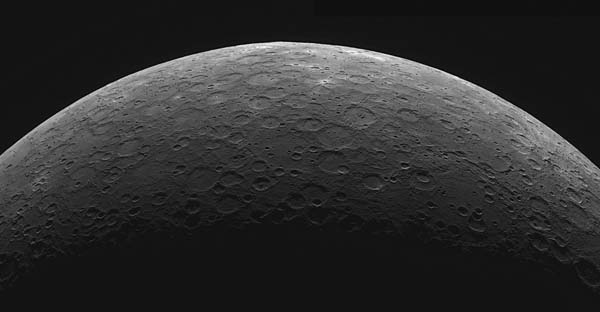Visit to a Small, Cold Planet
Ancient Romans named Mercury for their messenger of the gods

It’s out there spinning, tied by gravity’s leash to the sun. Round and round it runs, a small planet vacillating between freezing and burning according to whether it’s night or day. Mercury’s temperatures can fall to -290 Fahrenheit at night, and can rise to 800 degrees Fahrenheit by day. That day is, according to NASA, 175.97 Earth days long. Long day’s journey into night.
It’s one of the four terrestrial planets and it’s the planet closest to the sun. It’s slightly larger than Earth’s moon, with a landscape smacked and pocked by craters, which are impact scars of comets and meteoroids. The thin atmosphere is too thin to burn them up upon entry. These are old craters.
Volcanoes to coat old craters with hot lava are also lacking. Volcanoes died out early in Mercury’s history. Because it’s so small, its hot core cooled off during its first billion years. The cooling-off process caused the planet to contract, which is likely why Mercury has tremendous cliffs whose faces rise straight up to nearly a mile high. In the contracting and crumbling of the crust, some parts were left sticking up.
Mercury has a big basin, Caloris Basin, almost a thousand miles in diameter, made by an immense asteroid impact a long time ago. The planet’s orbit traces the shape of an egg, so that its distance from the sun varies from 29 million to 43 million miles. If you were to stand on Mercury at perihelion (when its orbit veers closest to the Sun), you would see our Sun three times as big as we see it from here.
Another thing about Mercury, it has ice on its poles, deep within craters, ice probably delivered by comets.
The ancient Romans named the planet Mercury for their messenger god. In 2008 and 2009, NASA’s Messenger spacecraft performed three flybys of Mercury. In March 2011 the planet’s gravity helped pull the Messenger into orbit, where it remains.
The god Mercury was the Roman version of Hermes of ancient Greece. Hermes was a stealer of cattle, a player of the lyre, a cooker-up of tricky schemes, a trickster, a border crosser from light to dark and back to light. (I’m reading Lewis Hyde’s translation of the “Homeric Hymn to Hermes.”)
If you want the richest, most tantalizing, most complex, most profound, most engrossing ramble through the spiritual and psychological world of that mercurial figure, the trickster (now that we’ve moved from the planet Mercury to its namesake), try Trickster Makes This World by Lewis Hyde. Many of us will live without ever seeing Mercury (the planet is too close to the sun to see most of the time, though it’s visible at sunset). But to live without ever experiencing Lewis Hyde’s book on its namesake—that would be sad.

